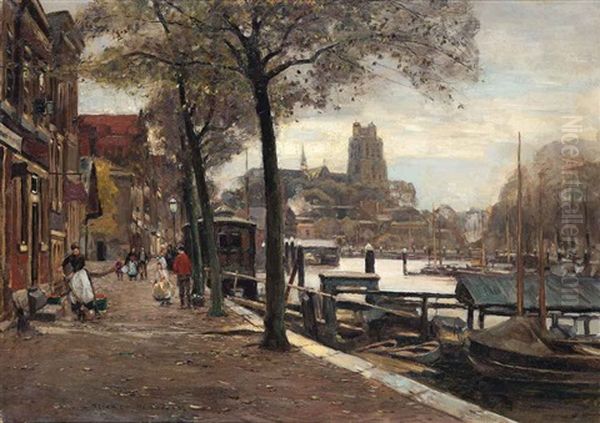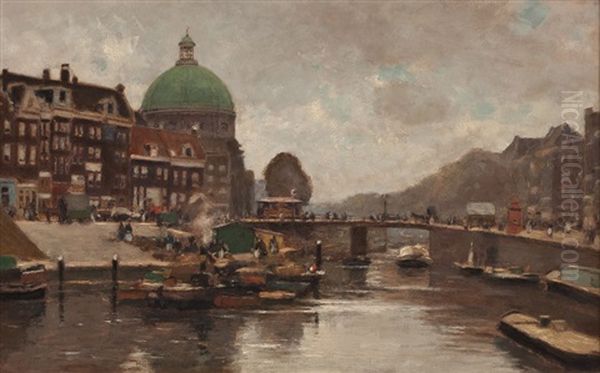Heinrich Hermanns (1862–1942) stands as a significant figure in German art history, particularly associated with the later developments of the Düsseldorf School of painting. A prolific painter of landscapes and marine scenes, his work captured the changing atmospheres of Germany, the Netherlands, Italy, and France with a sensitivity to light and colour that evolved throughout his career. Working primarily in oil and watercolour, Hermanns built a reputation through consistent exhibition presence and the enduring appeal of his evocative depictions of harbours, canals, cities, and coastlines.
Early Life and Artistic Formation
Born in the vibrant city of Düsseldorf in 1862, Heinrich Hermanns grew up in an environment steeped in artistic tradition. Düsseldorf was, at the time, one of Germany's most important art centres, largely due to the influence of the Kunstakademie Düsseldorf (Düsseldorf Art Academy). It was natural, therefore, that a young man with artistic inclinations would gravitate towards this institution.
Hermanns enrolled at the Düsseldorf Art Academy, studying formally between 1883 and 1893. This period provided him with rigorous training in the academic traditions that still held sway, emphasizing draughtsmanship, composition, and a faithful representation of reality. During his time at the Academy, he benefited from the tutelage of several influential figures. Among his most notable teachers was Eugen Dücker (1841–1916), a landscape painter of Estonian origin who had himself succeeded the renowned Oswald Achenbach at the Academy. Dücker steered landscape painting at Düsseldorf towards a more intimate realism and a greater emphasis on capturing atmospheric conditions, moving away from the heroic or overly romanticized views of earlier generations.
Other instructors included Heinrich Lauenstein (1835–1910), known for religious subjects and his role in decorative painting, and Georg Heinrich Crola (1804–1879), though Crola's influence would have been early or indirect given the dates. Perhaps more significantly in terms of landscape, Johann Peter Theodor Janssen (1844–1908), primarily a history painter, also taught at the Academy during Hermanns' time. The foundational training under these masters equipped Hermanns with technical proficiency, even as he began to forge his own path.
The Düsseldorf School Context

To understand Hermanns' place in art history, one must appreciate the legacy of the Düsseldorf School. Flourishing primarily between the 1820s and the 1870s, this movement, centred around the Academy, became internationally renowned. Early proponents like Johann Wilhelm Schirmer (1807–1863) established a strong tradition of landscape painting. The school was particularly known for its detailed, often narrative or allegorical landscapes, and later, for the dramatic, technically brilliant works of brothers Andreas Achenbach (1815–1910) and Oswald Achenbach (1827–1905).
By the time Hermanns was studying, the high tide of the original Düsseldorf School had passed, and new influences, particularly from French Realism and Impressionism, were beginning to permeate German art. Instructors like Dücker represented this transitional phase, encouraging plein-air (outdoor) sketching and a more naturalistic approach to light and atmosphere. Hermanns emerged from this environment, technically grounded in the Düsseldorf tradition but open to contemporary trends.
He did not work in isolation. Hermanns became associated with fellow artists who shared similar interests. He was a co-founder, alongside his former teacher Eugen Dücker, Olof Jernberg (1855–1935), Eugen Kampf (1861–1933), and Helmuth Liesegang (1858–1947), of the "St. Lukas Club" (Lucas-Club). This group aimed to revitalize landscape painting in Düsseldorf, integrating modern influences while maintaining high technical standards. They often exhibited together, representing a progressive wing within the Düsseldorf art scene.
Travels and Development of Style
Travel was essential to Hermanns' artistic development, providing him with fresh subjects and diverse lighting conditions. He frequently journeyed through Germany, but his trips abroad were particularly influential. The Netherlands became a favourite destination, its canals, harbours, windmills, and distinctive townscapes offering endless inspiration. Cities like Amsterdam and, notably, Dordrecht, feature prominently in his oeuvre. His depictions of Dutch scenes often emphasize the interplay of water, sky, and architecture, capturing the moist, diffused light typical of the region.
Hermanns also travelled extensively in Italy and France. His time in Italy, particularly visits to Naples and the Amalfi coast, resulted in works bathed in the brighter, warmer light of the Mediterranean. Paintings like Im Hafen von Neapel showcase his ability to adapt his palette and technique to different climes, capturing the bustling activity and sun-drenched architecture of the southern harbour. Trips to France likely exposed him further to Impressionist techniques and subjects, although his work generally retained a stronger structural foundation than that of many French Impressionists like Claude Monet (1840–1926) or Camille Pissarro (1830–1903).

His style evolved from the tighter realism of his early training towards a looser, more atmospheric approach, particularly evident in his watercolours and later oils. He became adept at rendering reflections on water, the subtle gradations of twilight, and the hazy air of harbours and city streets. While often associated with Impressionism due to his focus on light and atmosphere, his work typically maintains a clear sense of form and place, aligning him perhaps more closely with the German Impressionist movement, exemplified by artists like Max Liebermann (1847–1935), Lovis Corinth (1858–1925), and Max Slevogt (1868–1932), who adapted French techniques to German sensibilities.
Key Themes and Subjects
Hermanns consistently returned to certain themes throughout his career. Harbours and coastal scenes were a major focus. He depicted the working life of ports, capturing fishing boats, quaysides, and the reflections of masts and buildings in the water. These scenes allowed him to explore complex compositions and the effects of light on different surfaces – water, stone, wood, and sail. His Dutch harbour scenes, in particular, resonate with the tradition of marine painting established by artists of the Hague School, such as Hendrik Willem Mesdag (1831–1915) and Jacob Maris (1837–1899).
Cityscapes, especially those featuring canals or rivers, were another favourite subject. He painted numerous views of Amsterdam, Dordrecht, and other Dutch towns, often focusing on quiet canals lined with traditional houses or bustling market squares. These works demonstrate his skill in architectural rendering, combined with an ability to evoke the unique mood of each location. German cities, including his native Düsseldorf, also appeared in his work.
Pure landscapes, while perhaps less numerous than his marine and city views, were also part of his output. These often depicted the German countryside or coastal areas, rendered with the same attention to atmospheric detail. Whether painting a sunlit Italian harbour, a misty Dutch canal, or a twilight scene on the German coast, Hermanns' primary concern was often the accurate and evocative portrayal of light and atmosphere. His use of watercolour was particularly suited to capturing transient effects, allowing for fluid washes and luminous transparency.
Representative Works
Several works stand out as representative of Hermanns' style and thematic interests.
Im Hafen von Neapel. Fischerboote in der Sonne vor dem Palazzo Immacolata (In Naples Harbour. Fishing Boats in the Sun before the Palazzo Immacolata), dated 1907, is a prime example of his Italian subjects. This oil painting captures the bright Mediterranean sunlight reflecting off the water and illuminating the colourful fishing boats and waterfront buildings. It demonstrates his skill in handling strong contrasts of light and shadow and conveying the lively atmosphere of the port.
Figures on the Quay, Dordrecht is another significant oil painting. This work typifies his Dutch scenes, likely depicting the busy quayside of Dordrecht, a city he painted frequently. The composition probably features figures engaged in daily activities, set against the backdrop of moored boats and characteristic Dutch architecture. Such paintings highlight his interest in genre elements within a landscape or cityscape setting, and his ability to capture the specific quality of light in the Netherlands. The dimensions noted (25½ x 35½ inches) suggest a substantial canvas.
Other typical titles attributed to him, such as Amsterdam bei Nacht (Amsterdam by Night) or Holländische Stadtansicht (Dutch City View), further underscore his focus on urban scenes and atmospheric conditions, including challenging nocturnal light effects. Works like Evening Mood on a Dutch Canal emphasize his talent for capturing the subtle beauty of twilight, using a nuanced palette and soft brushwork to convey tranquility and fading light. These paintings showcase his mastery of tone and his ability to imbue scenes with a distinct emotional quality.
Exhibitions, Recognition, and Legacy
Heinrich Hermanns was an active participant in the German art world. Starting in 1886, he regularly exhibited his works in major German cities, including Düsseldorf, Berlin, Munich, and Dresden. This consistent presence helped establish his reputation among collectors and critics. His skill was formally recognized early on; in 1890, he received an honorary certificate in Düsseldorf, acknowledging his artistic achievements.
A significant honour came later in his career when, in 1918, he was awarded an honorary doctorate, likely reflecting his long-standing contribution to the arts and his respected position within the Düsseldorf art community. His association with the St. Lukas Club and his role as a prominent landscape and marine painter solidified his status.
Today, works by Heinrich Hermanns are held in public collections, most notably in the Museum Kunstpalast in Düsseldorf, which houses a significant collection of works associated with the Düsseldorf School. His paintings also appear regularly on the art market, where they command respectable prices, indicating continued appreciation among collectors for his technical skill and evocative portrayals. Auction records show consistent interest in his oils and watercolours, particularly those depicting his popular Dutch and Italian subjects.
Despite these markers of success during his lifetime and continued market presence, Heinrich Hermanns has not been the subject of extensive academic research in the same way as the leading figures of German Impressionism or the earlier pioneers of the Düsseldorf School. His position is perhaps that of a highly accomplished practitioner working within established traditions while subtly incorporating modern influences, rather than a radical innovator. His art represents a bridge between 19th-century realism and the atmospheric concerns of Impressionism, executed with considerable technical finesse.
Art Historical Significance
Heinrich Hermanns occupies a solid place within the narrative of late 19th and early 20th-century German art. He represents the evolution of the Düsseldorf School's landscape tradition, moving away from the highly detailed or dramatic styles of the mid-century towards a greater emphasis on capturing fleeting moments of light and atmosphere. His connection with Eugen Dücker and the St. Lukas Club places him within a group of artists seeking to modernize landscape painting in Düsseldorf.
His frequent depiction of Dutch subjects connects him to a broader European interest in the landscapes and cityscapes of the Netherlands, shared by artists from the Hague School (like Anton Mauve, 1838-1888) and even French Impressionists. His Italian scenes demonstrate his versatility and his engagement with the tradition of northern European artists travelling south in search of classical motifs and brilliant light.
While not a revolutionary figure like Liebermann or Corinth, Hermanns mastered a particular vein of landscape and marine painting characterized by atmospheric sensitivity, strong compositional structure, and often, a quiet, contemplative mood. His work offers valuable insight into the artistic currents of his time, particularly the ways in which German artists navigated the legacy of academic training while responding to the new possibilities opened up by Realism and Impressionism.
Conclusion
Heinrich Hermanns was a dedicated and talented painter whose career spanned a period of significant change in European art. Rooted in the strong technical traditions of the Düsseldorf Academy, he developed a distinctive style focused on the nuanced depiction of light and atmosphere in landscapes, cityscapes, and marine scenes. His travels, particularly to the Netherlands and Italy, provided rich subject matter, which he rendered with skill and sensitivity in both oil and watercolour. Remembered through his numerous exhibitions, the honours he received, and the presence of his works in collections and on the art market, Hermanns remains an important representative of German landscape painting in the era bridging late Romanticism and Impressionism. His paintings continue to appeal through their evocative beauty and masterful capture of place and mood.